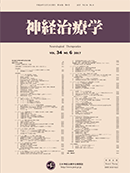Volume 40, Issue 3
Displaying 51-88 of 88 articles from this issue
-
2023 Volume 40 Issue 3 Pages 283-286
Published: 2023
Released on J-STAGE: August 21, 2023
Download PDF (422K) -
2023 Volume 40 Issue 3 Pages 287-291
Published: 2023
Released on J-STAGE: August 21, 2023
Download PDF (1052K) -
2023 Volume 40 Issue 3 Pages 292-294
Published: 2023
Released on J-STAGE: August 21, 2023
Download PDF (361K)
-
2023 Volume 40 Issue 3 Pages 295
Published: 2023
Released on J-STAGE: August 21, 2023
Download PDF (248K) -
2023 Volume 40 Issue 3 Pages 296
Published: 2023
Released on J-STAGE: August 21, 2023
Download PDF (227K) -
2023 Volume 40 Issue 3 Pages 297
Published: 2023
Released on J-STAGE: August 21, 2023
Download PDF (201K) -
2023 Volume 40 Issue 3 Pages 298-300
Published: 2023
Released on J-STAGE: August 21, 2023
Download PDF (340K) -
2023 Volume 40 Issue 3 Pages 301
Published: 2023
Released on J-STAGE: August 21, 2023
Download PDF (210K)
-
2023 Volume 40 Issue 3 Pages 302
Published: 2023
Released on J-STAGE: August 21, 2023
Download PDF (282K) -
2023 Volume 40 Issue 3 Pages 303
Published: 2023
Released on J-STAGE: August 21, 2023
Download PDF (161K) -
2023 Volume 40 Issue 3 Pages 304-306
Published: 2023
Released on J-STAGE: August 21, 2023
Download PDF (753K) -
2023 Volume 40 Issue 3 Pages 307-310
Published: 2023
Released on J-STAGE: August 21, 2023
Download PDF (461K) -
2023 Volume 40 Issue 3 Pages 311-314
Published: 2023
Released on J-STAGE: August 21, 2023
Download PDF (505K)
-
2023 Volume 40 Issue 3 Pages 315
Published: 2023
Released on J-STAGE: August 21, 2023
Download PDF (232K) -
2023 Volume 40 Issue 3 Pages 316-319
Published: 2023
Released on J-STAGE: August 21, 2023
Download PDF (876K) -
2023 Volume 40 Issue 3 Pages 320-323
Published: 2023
Released on J-STAGE: August 21, 2023
Download PDF (397K) -
2023 Volume 40 Issue 3 Pages 324-327
Published: 2023
Released on J-STAGE: August 21, 2023
Download PDF (399K) -
2023 Volume 40 Issue 3 Pages 328-333
Published: 2023
Released on J-STAGE: August 21, 2023
Download PDF (1871K)
-
2023 Volume 40 Issue 3 Pages 334
Published: 2023
Released on J-STAGE: August 21, 2023
Download PDF (292K) -
2023 Volume 40 Issue 3 Pages 335-339
Published: 2023
Released on J-STAGE: August 21, 2023
Download PDF (1630K) -
2023 Volume 40 Issue 3 Pages 340-344
Published: 2023
Released on J-STAGE: August 21, 2023
Download PDF (669K) -
2023 Volume 40 Issue 3 Pages 345-348
Published: 2023
Released on J-STAGE: August 21, 2023
Download PDF (436K) -
2023 Volume 40 Issue 3 Pages 349-350
Published: 2023
Released on J-STAGE: August 21, 2023
Download PDF (338K)
-
2023 Volume 40 Issue 3 Pages 351
Published: 2023
Released on J-STAGE: August 21, 2023
Download PDF (257K) -
2023 Volume 40 Issue 3 Pages 352-354
Published: 2023
Released on J-STAGE: August 21, 2023
Download PDF (368K) -
2023 Volume 40 Issue 3 Pages 355-358
Published: 2023
Released on J-STAGE: August 21, 2023
Download PDF (1606K) -
2023 Volume 40 Issue 3 Pages 359-362
Published: 2023
Released on J-STAGE: August 21, 2023
Download PDF (553K) -
Treatment strategies and future perspectives for Parkinson disease in the “Device Aided Therapy Era”2023 Volume 40 Issue 3 Pages 363-367
Published: 2023
Released on J-STAGE: August 21, 2023
Download PDF (1387K)
-
2023 Volume 40 Issue 3 Pages 368-376
Published: 2023
Released on J-STAGE: August 21, 2023
Download PDF (1835K) -
2023 Volume 40 Issue 3 Pages 377-384
Published: 2023
Released on J-STAGE: August 21, 2023
Download PDF (872K) -
2023 Volume 40 Issue 3 Pages 385-390
Published: 2023
Released on J-STAGE: August 21, 2023
Download PDF (470K) -
2023 Volume 40 Issue 3 Pages 391
Published: 2023
Released on J-STAGE: August 21, 2023
Download PDF (185K)
-
2023 Volume 40 Issue 3 Pages 392-396
Published: 2023
Released on J-STAGE: August 21, 2023
Download PDF (825K)
-
2023 Volume 40 Issue 3 Pages 397-400
Published: 2023
Released on J-STAGE: August 21, 2023
Download PDF (335K)
-
2023 Volume 40 Issue 3 Pages 401-406
Published: 2023
Released on J-STAGE: August 21, 2023
Download PDF (1702K)
-
2023 Volume 40 Issue 3 Pages 407-410
Published: 2023
Released on J-STAGE: August 21, 2023
Download PDF (341K) -
2023 Volume 40 Issue 3 Pages 411
Published: 2023
Released on J-STAGE: August 21, 2023
Download PDF (148K) -
2023 Volume 40 Issue 3 Pages 412
Published: 2023
Released on J-STAGE: August 21, 2023
Download PDF (133K)
